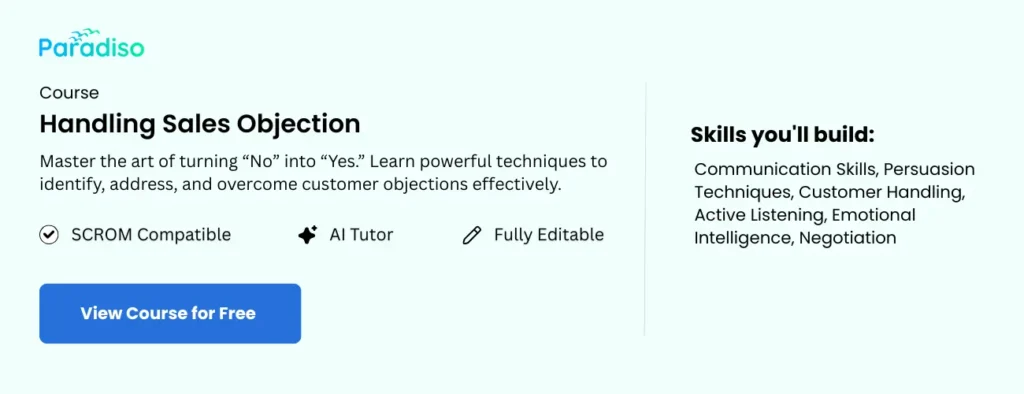
THANK YOU
FOR YOUR INFORMATION
One of our expert will be in touch with you…

In today’s highly competitive sales environment, hesitation from potential buyers often presents a formidable obstacle that can prevent successful conversions. Customers may doubt due to factors such as information overload, lack of trust, or previous negative experiences. Such moments of uncertainty are natural when making significant purchasing decisions, but they can be effectively addressed through handling objections in sales training for employees and strategic communication techniques.
One of the most impactful tools for overcoming buyer hesitation is storytelling. When crafted thoughtfully, stories humanize products or services, foster emotional connections, and build credibility. By sharing relatable narratives, sales professionals can resonate with potential clients’ needs, fears, and aspirations reducing doubts and fostering trust. Understanding the psychology behind buyer hesitation and leveraging storytelling as a persuasive strategy combined with effective handling objections in sales training for employees offers a powerful way to improve sales outcomes and close more deals.
Recent brain research reveals that storytelling activates multiple brain regions involved in language, emotion, and sensory processing. When a story is told, the listener’s brain mirrors experiences—a phenomenon known as neural coupling (Hasson et al., 2015). This mirroring fosters empathy and shared understanding, making messages more memorable and persuasive. Additionally, the limbic system, responsible for emotions, lights up during engaging narratives, increasing emotional involvement and influencing decision-making (Saarimäki et al., 2017).
Stories also stimulate dopaminergic pathways linked to reward and motivation, making prospects more receptive to messaging and more likely to take action. This neurological basis explains why stories tend to be more effective in sales than data or facts alone; they create visceral connections that rational arguments can’t easily replicate.
Emotion plays a pivotal role in sales storytelling. Research from the Yale Center for Emotional Intelligence shows that emotionally engaging stories increase activity in the prefrontal cortex areas associated with intuition and judgment (Mayer et al., 2016). When prospects emotionally connect with a story—such as overcoming adversity or fulfilling a dream—they form mental associations with the product or service, influencing their buying behavior.
Stories also activate mirror neurons, which simulate the feelings or actions described, fostering empathy and understanding. This empathetic response reduces resistance, builds rapport, and establishes trust—key elements in closing sales. Effective sales stories often highlight relatable challenges and triumphant solutions, making complex ideas accessible and emotionally compelling.
By integrating these elements, sales professionals can craft compelling narratives that inform and inspire action—thanks to storytelling’s profound psychological impact.

Understanding the unique motivations and challenges of diverse customer segments enables crafting resonant stories. For example:
Personalized stories increase engagement by up to 55%, aligning with customer needs and easing doubts.
Strategic storytelling should occur throughout the sales cycle, addressing concerns and reaffirming value:
Enhance impact by adapting storytelling methods to different formats:
Ground stories in real data and verified outcomes—such as case studies showing a 30% efficiency increase—to enhance trustworthiness and persuasiveness.
Investing in training—via role-playing, workshops, or feedback—helps teams craft compelling narratives and deliver them confidently, making storytelling a strategic sales asset.
Crafting stories that resonate with various customer personas involves understanding their specific needs and challenges:
Using authentic, industry-specific stories—well-structured with clear problems, solutions, and results—builds credibility and trust. Tailoring stories for high-level executives, technical teams, or daily users accelerates engagement and enhances the sales process.
Strategic storytelling transforms the sales process into a human connection. From initial trust-building to closing the deal, stories foster confidence and memorable impressions:
Effective storytelling makes your solutions resonate on an emotional level, building trust and motivation at every step.
Effective storytelling is critical for standing out in today’s crowded market. Paradiso’s courses are designed to develop your sales team’s narrative skills, enabling them to build trust, address pain points, and close more deals.
Studies show stories are 22 times more memorable than facts (Harvard Business Review), making them vital for influencing buyer behavior. Transforming abstract features into relatable benefits, storytelling helps prospects visualize the value of your solutions.
Participants report increased engagement, higher conversion rates, and stronger client relationships after training. Paradiso’s program helps sales teams become trusted advisors through storytelling mastery, boosting overall performance and revenue.
In today’s competitive landscape, mastering storytelling is vital for overcoming buyer hesitation and closing more deals. A compelling narrative captures prospects’ attention, builds trust, and makes your solutions memorable. Sharing relatable, authentic stories helps prospects see themselves in your success story, increasing confidence in your offerings.
Strategies such as customizing stories for different customer types, integrating narratives throughout the sales cycle, and training teams in storytelling techniques significantly enhance sales performance. Resources like Paradiso Course Catalog provide comprehensive training that equips your sales team to utilize storytelling as a core strategic tool.
Investing in storytelling skills transforms your sales approach—leading to better engagement, stronger relationships, and sustained business growth.